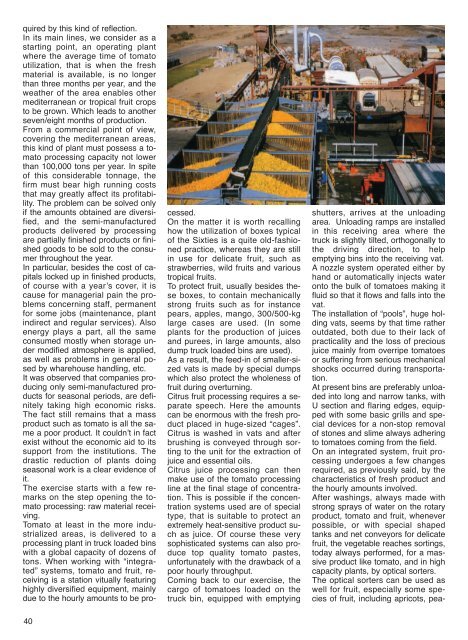Create successful ePaper yourself
Turn your PDF publications into a flip-book with our unique Google optimized e-Paper software.
quired by this kind of reflection.<br />
In its main lines, we consider as a<br />
starting point, an operating plant<br />
where the average time of tomato<br />
utilization, that is when the fresh<br />
material is available, is no longer<br />
than three months per year, and the<br />
weather of the area enables other<br />
mediterranean or tropical fruit crops<br />
to be grown. Which leads to another<br />
seven/eight months of production.<br />
From a commercial point of view,<br />
covering the mediterranean areas,<br />
this kind of plant must possess a tomato<br />
processing capacity not lower<br />
than 100,000 tons per year. In spite<br />
of this considerable tonnage, the<br />
firm must bear high running costs<br />
that may greatly affect its profitability.<br />
The problem can be solved only<br />
if the amounts obtained are diversified,<br />
and the semi-manufactured<br />
products delivered by processing<br />
are partially finished products or finished<br />
goods to be sold to the consumer<br />
throughout the year.<br />
In particular, besides the cost of capitals<br />
locked up in finished products,<br />
of course with a year’s cover, it is<br />
cause for managerial pain the problems<br />
concerning staff, permanent<br />
for some jobs (maintenance, plant<br />
indirect and regular services). Also<br />
energy plays a part, all the same<br />
consumed mostly when storage under<br />
modified atmosphere is applied,<br />
as well as problems in general posed<br />
by wharehouse handling, etc.<br />
It was observed that companies producing<br />
only semi-manufactured products<br />
for seasonal periods, are definitely<br />
taking high economic risks.<br />
The fact still remains that a mass<br />
product such as tomato is all the same<br />
a poor product. It couldn’t in fact<br />
exist without the economic aid to its<br />
support from the institutions. The<br />
drastic reduction of plants doing<br />
seasonal work is a clear evidence of<br />
it.<br />
The exercise starts with a few remarks<br />
on the step opening the tomato<br />
processing: raw material receiving.<br />
Tomato at least in the more industrialized<br />
areas, is delivered to a<br />
processing plant in truck loaded bins<br />
with a global capacity of dozens of<br />
tons. When working with “integrated”<br />
systems, tomato and fruit, receiving<br />
is a station vitually featuring<br />
highly diversified equipment, mainly<br />
due to the hourly amounts to be pro-<br />
40<br />
cessed.<br />
On the matter it is worth recalling<br />
how the utilization of boxes typical<br />
of the Sixties is a quite old-fashioned<br />
practice, whereas they are still<br />
in use for delicate fruit, such as<br />
strawberries, wild fruits and various<br />
tropical fruits.<br />
To protect fruit, usually besides these<br />
boxes, to contain mechanically<br />
strong fruits such as for instance<br />
pears, apples, mango, 300/500-kg<br />
large cases are used. (In some<br />
plants for the production of juices<br />
and purees, in large amounts, also<br />
dump truck loaded bins are used).<br />
As a result, the feed-in of smaller-sized<br />
vats is made by special dumps<br />
which also protect the wholeness of<br />
fruit during overturning.<br />
Citrus fruit processing requires a separate<br />
speech. Here the amounts<br />
can be enormous with the fresh product<br />
placed in huge-sized “cages”.<br />
Citrus is washed in vats and after<br />
brushing is conveyed through sorting<br />
to the unit for the extraction of<br />
juice and essential oils.<br />
Citrus juice processing can then<br />
make use of the tomato processing<br />
line at the final stage of concentration.<br />
This is possible if the concentration<br />
systems used are of special<br />
type, that is suitable to protect an<br />
extremely heat-sensitive product such<br />
as juice. Of course these very<br />
sophisticated systems can also produce<br />
top quality tomato pastes,<br />
unfortunately with the drawback of a<br />
poor hourly throughput.<br />
Coming back to our exercise, the<br />
cargo of tomatoes loaded on the<br />
truck bin, equipped with emptying<br />
shutters, arrives at the unloading<br />
area. Unloading ramps are installed<br />
in this receiving area where the<br />
truck is slightly tilted, orthogonally to<br />
the driving direction, to help<br />
emptying bins into the receiving vat.<br />
A nozzle system operated either by<br />
hand or automatically injects water<br />
onto the bulk of tomatoes making it<br />
fluid so that it flows and falls into the<br />
vat.<br />
The installation of “pools”, huge holding<br />
vats, seems by that time rather<br />
outdated, both due to their lack of<br />
practicality and the loss of precious<br />
juice mainly from overripe tomatoes<br />
or suffering from serious mechanical<br />
shocks occurred during transportation.<br />
At present bins are preferably unloaded<br />
into long and narrow tanks, with<br />
U section and flaring edges, equipped<br />
with some basic grills and special<br />
devices for a non-stop removal<br />
of stones and slime always adhering<br />
to tomatoes coming from the field.<br />
On an integrated system, fruit processing<br />
undergoes a few changes<br />
required, as previously said, by the<br />
characteristics of fresh product and<br />
the hourly amounts involved.<br />
After washings, always made with<br />
strong sprays of water on the rotary<br />
product, tomato and fruit, whenever<br />
possible, or with special shaped<br />
tanks and net conveyors for delicate<br />
fruit, the vegetable reaches sortings,<br />
today always performed, for a massive<br />
product like tomato, and in high<br />
capacity plants, by optical sorters.<br />
The optical sorters can be used as<br />
well for fruit, especially some species<br />
of fruit, including apricots, pea-




